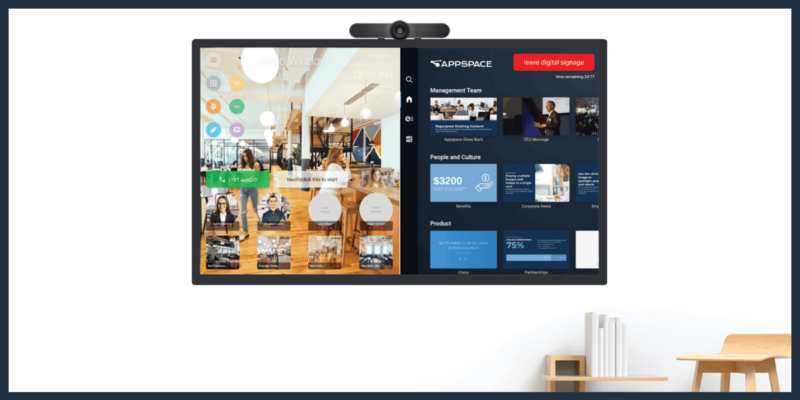PART II: Better than Being There — Three Keys to AV Delivering UC&C

(It’s a long post – but I think it might be a good one)
In my last blog I talked about the vision of Unified Communications and Collaboration (UC&C) and how UC&C can be better than being there. I of course acknowledged the importance of face-to-face meetings. To recap, I emphasized that when you use UC&C, you have all of your resources available to you and thusly your meetings can be very productive.
In this article I will expand on how AV designers and integrators need to bring their expertise to the forefront as they ADD IT to their solution mix. The important key point to remember is that AV can successfully enter the AV/IT market (or the UC&C market) and even dominate their area in it as long as they stay focused on the fact that what they are doing is ADDING IT to their current AV solution offering. If AV is their core competency, they need to go into IT knowing that IT features and functionalities can and should be leveraged as an add-on to their core, but this should not be an attempt at going head to head with IT integrators or resellers. This may even be an opportunity to partner for some. Simply picking up IT products and IT integration and competing with those who have been doing it for decades is a tough row to hoe and is often a losing proposition. This article focuses on what AV has to add to IT and how that makes UC&C a complete offering.
I will do one more clarification because I know this will generate a lot of discussion as discussions like this has done in the past. I am not advocating that AV is here to stay just the way it is for the long run and that change does not needed. I am also not stating that AV companies should all go out and become IT companies because of impending doom. What I am stating is that AV is due for a natural evolution in their business. I am stating that there is a shift that is being driven by; new technologies, the way space is being used in business and the way that businesses are setting policies, procedures and process to support more collaboration and the way global teams work together. This evolution must be addressed by AV companies and better yet, there is great opportunity in it.
I guess I should clarify what I am saying when I discuss UC&C and IT. When I mention UC&C – I will give you my definition (sorry Wikipedia), I am referring to the space where telephony, computer networking, data networking and collaborative technologies all come together. Some of the most common examples of UC&C are video conferencing, but those often lack the collaboration element and use very little of the data networking element. Fully integrated rooms where videoconferencing, interactive whiteboards that allow for Bring Your Own Device (BYOD) are integrated with the phone system, computer system and also allows for interactivity and integration with the entire network system including desktops, servers and network resources are better examples of full UC&C. As for IT (again my own definition – not Wikipedia), I am talking about the network and the network appliances. This general term can also include the Local Area Network (LAN) and Wide Area Network (WAN) technologies, applications and appliances. I guess I am saying that IT is a smaller part of UC&C and is also higher on the hierarchy when you look at the bigger picture. This is because IT can cover an entire enterprise where UC&C can fit into a smaller subset at times (for a better definition of UC&C and AV/IT check out this post by Corey Moss). Another important thing to remember is that the terms being used are subject to the speaker’s definition. When you are talking to an IT guy about his network he gets to define it how he wants and you shouldn’t correct him. A network is an IT guy’s baby and when you correct him about terminology he is using about his baby, you might as well be telling him he has an ugly baby.
It is important for AV companies to focus on their core competencies and then grow their IT and UC&C branch to add the following value to these UC&C evolution areas:
1. The Technology — I am amazed by all of the advancements in UC&C. It is hard to break them all down, but if we look at a few of them like networked AV, encoding and decoding, FPGA v. ASICS, gigabit networks, fiber optic networking, 4K, HDBaseT camera technology and size, OLED, touchscreen tech, wireless applications, etc. we see that you don’t have to look far to see that technology in UC&C has come a long way in a very short period of time. Just as amazing is that the price points for these technologies has have come down exponentially. A lot of these advancements and pricing advantages have happened in the very recent past. These advancements have found their way to implementation in consumer products as well. The fact that these advancements have been implemented in consumer products is has a significant impact in the corporate market for UC&C. There was a time when UC&C was a black art. The only people who knew what new technologies were available were the technologist and really high-end geeks, but now that these leading edge technologies are prolific and in the hands of the masses in home theater and home office. These end-user consumer applications are often driving what goes in the boardroom and conference room. The consumer looks at the fact that they can make a clear video call with clear audio to their child who is studying in South Korea and wonder why they can’t easily make the same call from a huddle room in their office to a business partner around the world. The IT guy had better make it happen regardless of network security, bandwidth issues, service provider problems or mismatched protocols or carriers. “It works at home via consumer off the shelf products”, thinks the consumer, “so it had better work in my boardroom.” The evolution of expectations has gone from when there was a time that only the fortune 100 had it so that made some companies want it. Then it went to people in Hollywood had it (like Jack Bauer (24) had it, so some companies wanted it. Now, we see that the evolution of expectation has come to the realization that a teenager installed one’s house and now those people want it at work.
What can AV do about the Technology Evolution? In order for AV to add value to the technology evolution in UC&C the emphasis still needs to remain on the fact that AV is adding IT to their solutions mix and that their core competency is still enhancing the physical environment. Marketing and selling the value that AV has in enhancing UC&C is where the challenge is, but it is also where the greatest value is. Once the end user understands the value that AV adds to the solution, end users will realize that using AV to complete their UC&C deployment makes perfect sense. A lot of people will argue as to why one should try to market something or sell something that the end user or target customer doesn’t know they need or isn’t asking for. To that, I respond with a quote that is sometimes attributed to Henry Ford: “If I had asked my customers what they wanted, they would have told me a faster horse.” The quote may or may not have been made by Henry Ford, but the point is well made and his grandson believes he said it. The point is that sometimes it is our responsibility to educate our customers as to what is best for them and deliver more than what they are asking for and more than they had ever hoped for.
The fact that AV can speak IT and do it with a UC&C result as the end goal will drive the business their direction. The competition in the UC&C market is most often an IT or Telecom integrator. Trying to compete with them on a technology level is going to be tough. So where is the unique value that AV can bring? To be highly differentiated I still stand by my earlier posts/blogs/articles that state that AV maintains value in lighting, acoustics, camera placement, control system design, AV signal routing and signal integrity design, microphone placement, audio reinforcement design, display type, display size and display location selection, etc. This is to say that the physical space is still where an AV designer and integrator is still the master and has much to offer. We still find that many UC&C or videoconferencing systems are not used as often as intended due to these three main reasons: they are not easy to use, the conferencing does not feel or sound natural and the system is not compatible with the system they are trying to connect with. AV designers and integrators are well suited to overcome these top three barriers and can best adapt to the use of cloud technologies to maximize the capabilities that the latest collaborative and bridging systems offer. AV designers and integrators can spend the time to become specialist in the UC&C areas that end users need with the AV expertise added that will bring the system to its highest functionality possible. It is important that AV add IT to their solutions mix by educating their staff and investing in the new technologies while still maintaining their strength in AV. I have said this before as well that the investment in IT can be done through partnerships, but should not be done halfheartedly. The evolution is here and AV companies must evolve as well.
2. Process and Policies — One of the other challenges we face is the shifting in the way business is being done. No longer are we using technology to get things done, but we are seeking out technologies to match how we expect to get things done. Our users expect to be able to collaborate the way they can meet online and share information in social media at work. Therefore policies and processes have to evolve as well. Things that used to be forbidden on networks or forbidden as a matter of corporate policy are now business requirements. We used to have strict policies against the usage of computers for social media and we had strict rules against iPads, Tablets or other personal devices being added to corporate networks. These are policies of the past and now we have policies and process that not only allow this type of behavior, but we have process in place that encourage it. We have meeting spaces that encourage impromptu meetings that require no prior scheduling through the corporate email system and the meeting space is an open space that looks almost like a café or even a garden area. Policies and processes have evolved to encourage collaboration and open communication. Corporations are looking for new and innovative ways to make their workforce more productive and more profitable. Can these things all be combined? There is a strong belief that using UC&C to build a more collaborative and team centric workforce will quickly yield more profits and higher productivity. With AV implementing UC&C we must find ways to help the evolution of processes and policies that will drive this in ways that other industries can’t.
What can AV do about the Process and Policies Evolution? – Seizing the opportunity in the evolution in process and policies for UC&C will involve understanding process improvement and having a strong business acumen. Personally, for this I used my LEAN Six Sigma training and Project Management Professional training and certification. These trainings, certifications and experience lend the background, knowledge and skill I need to support customers in changing their business approach along with the implementation of technology. Having your AV project managers be more than elevated technicians is key here. The AV industry is a little unique in that most of our project managers come from the technical side of the business. In many other industries project managers come from the business side of the house. Having a business education and background gives them an edge when they are working with large enterprises. For AV we need to adopt that approach. For those AV companies that have moved to this, I am sure they can attest to the fact that in dealing with large enterprise accounts having a project manager who knows project management and business pays in dividends. I have seen this work for others where the team approach is used and the account manager takes the role of business manager as well. The important thing to know is that there needs to be an approach where someone with a strong business acumen and an understanding of the industry that your customer is in needs to work on the team to help the customer with the development of an evolved set of policy and process to support UC&C. Executive buy-in is key to the successful deployment of AV in UC&C. If executives are not using the system and if they are not setting policy and process that support and drive the usage of the systems if will all be for not. The policies and process need to be built on the WHY of the system. Way back at the needs analysis the root causes, explicit and implied needs were uncovered. Now is the time to make sure that policies and procedures are developed to make sure the system that is developed and deployed is used in such a manner to address those needs. As an AV designer and integrator we need to take on the role of business process and UC&C consultant. This may require your organization getting some additional training like I have in LEAN Six Sigma or (Project Management Professional (PMP®) or similar business process related training and certifications.
3. Space Planning — Throughout my AV career I have heard AV designers and integrators discuss the importance of being included in the design process early. Architects and General Contractors are often overlooking AV in the initial phases of a project and that is often detrimental to the successful AV implementation or it at least makes the successful implementation a more difficult task. That has never been truer than today and in UC&C. With UC&C space planning is critical. The challenge continues that consumers are blasted regularly by manufacturers with the message that products are off the shelf, easy to implement and require minimal set up. The truth of the matter is that in a corporate boardroom environment or in a conference room these products require a lot of special handling and even more care when being integrated into a space that many people are using or a space that is used for a lot of different purposes. The evolution of space planning involves the user’s expectations just like the technology evolution did. For the space planning evolution I’ll use the Apple Store example. Everything in an Apple Store is sleek and clean. An Apple Store is used to demonstrate technology, but you see no wires and actually you see very little technology compared to the space you are in. You actually see a lot of clean white space instead. The evolution of the corporate boardroom and conference room has a very similar evolution as the Apple retail space did. The expectation is that there should be a lot of technology in the space, but nearly none of it should be seen. The space should remain clean and sleek yet highly functional.
What can AV do about the Evolution of Space Planning? – The space planning evolution is an area that AV can address better than almost any other industry. I will point out that furniture companies with space planning design capabilities that have a technology element can have the upper hand when they want, but that usually involves the expertise of an AV design and integration firm as well. I believe AV can best address that evolution of space planning because the unique requirements for lots of technology with a clean and sleek look challenges the acoustics, lighting placement of technology more than ever before. Telecom and IT provider who integrate UC&C will not have the knowledge, skill or experience to overcome the challenges that these environments bring (with major consideration to lighting and acoustics). AV designers and integrators will be there to save the day. AV will master the physics and bring solutions that balance the esthetics with natural sound, great looking video, properly placed cameras and microphones to give the feel of face-to-face meetings even when the meetings are taking place thousands of miles apart. The AV integrator that takes on the challenges of UC&C knowing that the value they bring is still their core competencies in AV and how they apply that competency in space planning will dominate their market. They will dominate as long as they can send the message right and to the right people. There is an aspect of this that goes far beyond enhancing the AV and making it work in the environment or making adjustments to the environment to better suit AV. When collaboration comes into the mix, considerations can be taken into account as to whether the users and presenters/collaborators will be sitting or standing. When space planning is done well in a collaborative environment, the space enhances the communication by making people comfortable and at ease. Here is an example: When all the participants are seated at bar height and the “presenter” is standing, everyone is actually at the same eye level. This makes it to where everyone feels a level of equality and is more likely to contribute to the collaborative discussion than if they are all seated at a lower level and being talked down to. Once AV integrators understand the IT side and combine this all together and work in the space planning aspects the environment becomes part of the reason people are more open and communicative.
Conclusion
Now that we have addressed three of the reasons market is growing (evolving), we can know how to address its growth. AV companies will approach these a little different, but ultimately the core ideas are the same. The end user’s goals are to better use their physical space, use their technology more efficiently and to set the right policy and process to support their team’s productivity and profitability. If your company can help your customers do this by giving them a UC&C system that is better than being there and that meets these three evolutionary goals, how can you lose?
Next week I will discuss how companies can be more collaborative by creating a TEAM atmosphere for their collaborators. TEAM = T=Trusted, E=Empowered, A=Active, M=Motivated. A great read to kick off this thought is from Cory Schaeffer.





